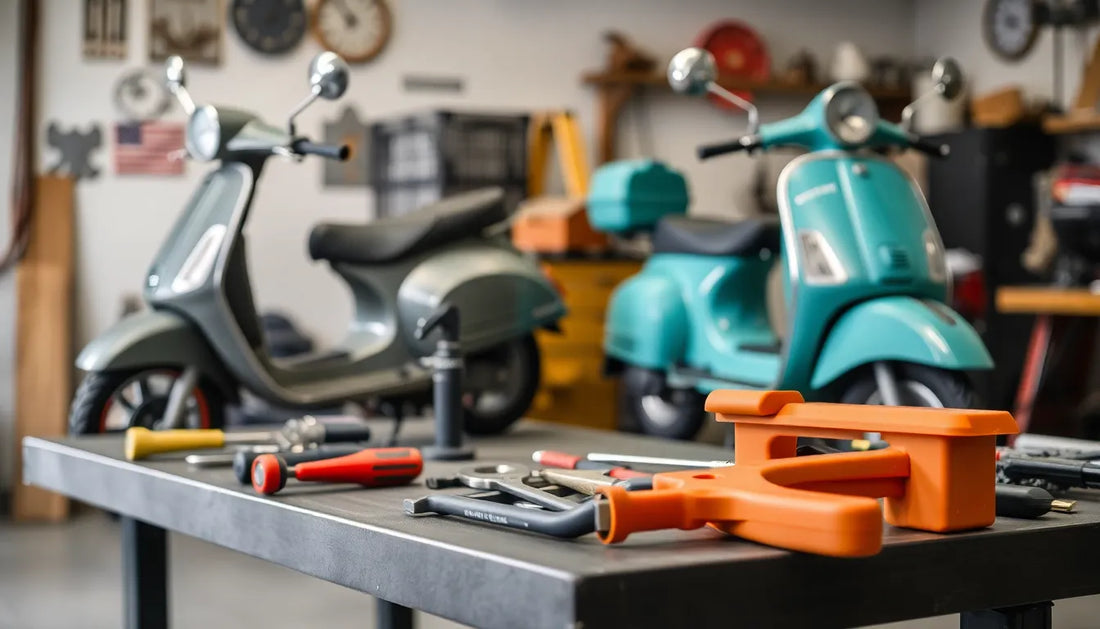
Essential Tips for Preparing Your Scooter or Moped for the Riding Season in 2025
Q9 PowerSports StaffShare
Introduction
As the riding season approaches in 2025, it's time to bring your scooter or moped out of hibernation and get it ready for the road. Proper preparation not only enhances your riding experience but also ensures your safety and the longevity of your vehicle. Whether you’re a seasoned rider or a newcomer to the world of scooters and mopeds, these essential tips will guide you through the necessary steps to prepare your Scooter or Moped for the upcoming season.
1. Inspect Your Tires
Your tires are the only point of contact between you and the road, making their condition crucial for safety and performance. Here’s how to properly inspect and prepare them:
- Check for proper inflation: Use a tire pressure gauge to ensure your tires are inflated to the manufacturer's recommended pressure. Under-inflated tires can lead to poor handling and increased wear.
- Examine tread depth: Look for even wear on the tread. If the tread is worn down to the indicators, it’s time to replace the tires. A simple test is to insert a penny into the tread; if you can see the top of Lincoln's head, your tires may need replacing.
- Inspect for damage: Look for cracks, bulges, or punctures that could compromise safety. If you find any damage, consult a professional for advice on whether to repair or replace your tires.
2. Change the Oil
Regular oil changes are essential for maintaining your scooter or moped's engine health. Follow these steps for a successful oil change:
- Refer to your owner’s manual: Check the recommended oil change interval for your specific model. Generally, changing the oil every 1,000 to 2,000 miles is advisable.
- Choose high-quality oil: Use oil that meets or exceeds the specifications outlined in your owner’s manual. Synthetic oils can offer better protection and performance.
- Dispose of used oil responsibly: Take your used oil to a recycling center or service station that accepts it. Never dispose of it in regular trash or pour it down the drain.
3. Check and Replace Fluids
In addition to oil, your scooter or moped requires several other fluids to function correctly. Here’s a checklist for fluid maintenance:
- Brake fluid: Check the level in your brake fluid reservoir and top it off if necessary. Replace it if it’s discolored or has absorbed moisture.
- Coolant: Ensure the coolant level is adequate. If it’s low, refill it with the appropriate type and consider flushing the system if it hasn’t been done in a while.
- Transmission fluid: Inspect the level and condition of your transmission fluid. Change it according to your model's specifications for optimal performance.
4. Test the Battery
A reliable battery is crucial for starting your scooter or moped. Here’s how to test and maintain your battery:
- Check for corrosion: Inspect the battery terminals for any signs of corrosion. Clean them with a mixture of baking soda and water if necessary.
- Measure the charge: Use a multimeter to check the battery voltage. A healthy battery should read around 12.6 volts. If it’s significantly lower, consider recharging or replacing it.
- Replace if necessary: If your battery is over three years old or shows signs of weakness, it’s wise to invest in a new one to avoid being stranded.
5. Clean and Lubricate Moving Parts
Maintaining cleanliness and lubrication of moving parts is vital for a smooth ride. Here are some steps to follow:
- Wash the exterior: Use mild soap and water to clean your scooter or moped, paying particular attention to hard-to-reach areas that may collect dirt and grime.
- Lubricate the chain: Apply chain lubricant to keep the chain running smoothly. Ensure you remove any excess to prevent attracting dirt.
- Inspect and clean brakes: Check the brake pads for wear and clean the brake components to ensure maximum effectiveness.
6. Check Lights and Signals
Visibility is key to safe riding, especially as the days grow longer in spring. Here’s how to ensure your lights and signals are functioning:
- Test all lights: Check that your headlights, taillights, and turn signals are working correctly. Replace any burnt-out bulbs promptly.
- Ensure reflectors are clean: Clean your reflectors to ensure they are visible to other drivers, especially at night.
- Consider adding extra visibility: Installing additional lights or reflective stickers can enhance your visibility on the road.
7. Review Safety Gear
Safety should always be your top priority when riding. Here’s a checklist to ensure you have the appropriate safety gear:
- Wear a DOT-approved helmet: Choose a helmet that fits snugly and complies with safety standards. Consider using a full-face helmet for maximum protection.
- Invest in protective clothing: Wear gear made from durable materials, including gloves, jackets, and pants that offer abrasion resistance.
- Consider visibility gear: Bright, reflective clothing can help others see you, especially in low-light conditions.
8. Plan for Maintenance and Repairs
As the season progresses, ongoing Scooter maintenance and repair is essential. Consider the following:
- Schedule regular maintenance: Create a maintenance schedule based on your riding habits and the recommendations in your owner’s manual.
- Learn basic repairs: Familiarize yourself with minor repairs and maintenance tasks. This knowledge can save you time and money.
- Keep a repair kit: Carry a basic toolkit and emergency supplies, including a tire repair kit, in case of roadside issues.
9. Familiarize Yourself with Local Laws
Before you hit the road, make sure you are aware of local laws and regulations regarding scooters and mopeds:
- Licensing: Check if you need a specific license or permit to operate your scooter or moped in your area.
- Insurance: Ensure you have appropriate insurance coverage that meets local requirements.
- Parking regulations: Familiarize yourself with where you can legally park your scooter or moped to avoid fines.
10. Enjoy the Ride!
After completing all the necessary preparations, it’s time to enjoy your first ride of the season. Here are some tips for a safe and enjoyable experience:
- Start slow: Take a short ride to get accustomed to your scooter or moped after a period of inactivity.
- Be mindful of road conditions: Watch for debris, potholes, and wet pavement, especially early in the season.
- Ride defensively: Always be aware of your surroundings and anticipate the actions of other drivers.
Conclusion
Preparing your scooter or moped for the riding season in 2025 is not just about maintenance; it's about ensuring a safe and enjoyable experience. By following these essential tips, you can hit the road with confidence and peace of mind. Embrace the freedom of riding, cherish the journey, and make the most of the beautiful days ahead!

1 comment
Great, clear, and practical tips that make preparing your scooter or moped for the 2025 riding season easy and stress-free!